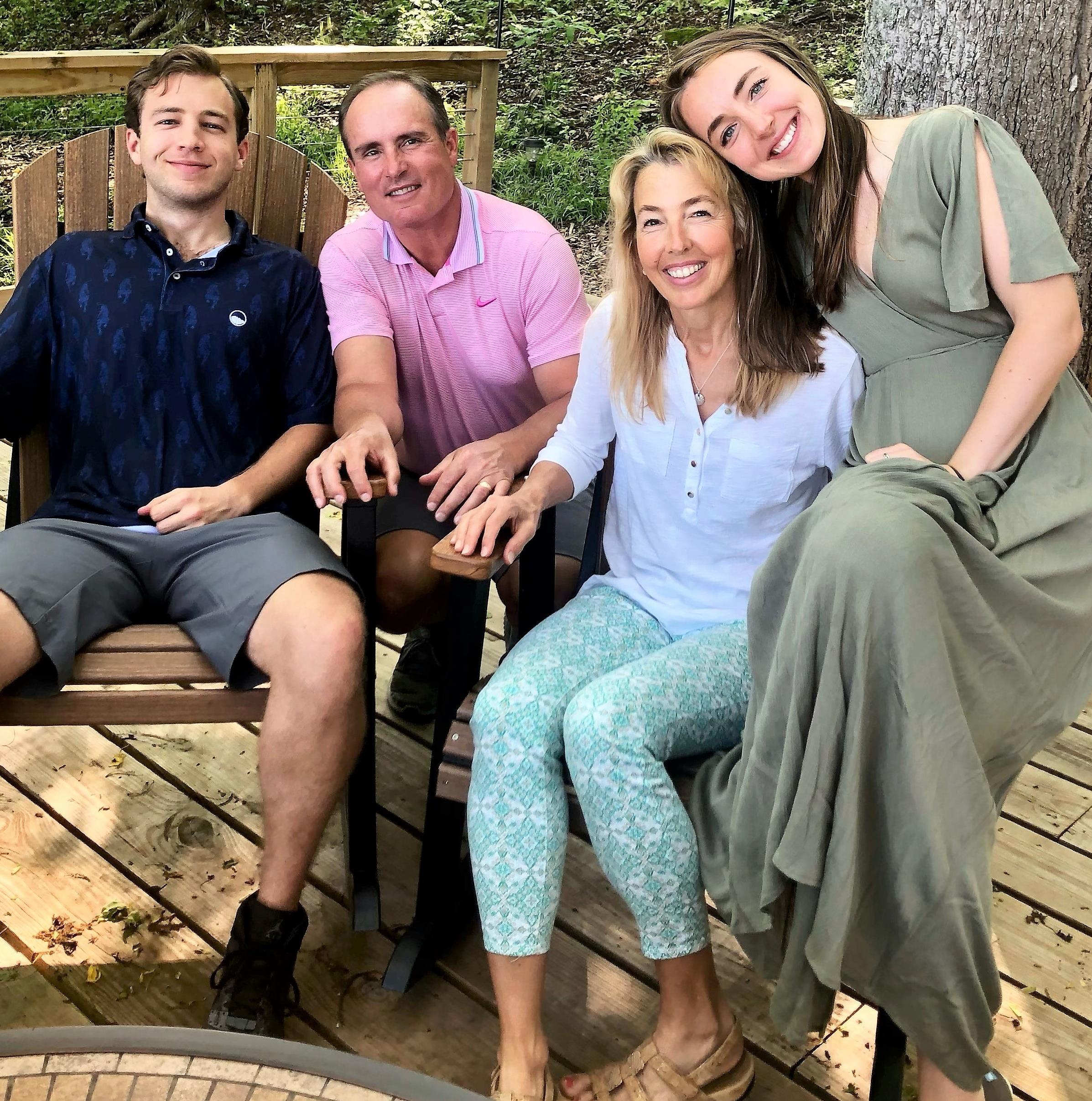Family Affected by CMT1A Makes a Cure Their ‘Endgame’
Written by |

The Stahl family, (from left): Austin, Kent, Michele, and Hunter. (Photo courtesy of the Stahl family)
It was an unexpected $1 million gift even for Kent and Michele Stahl.

Austin Stahl, 28, and sister Hunter Stahl, 27, pose for a photo on a ski trip. (Photo courtesy of Hunter Stahl)
The Charcot-Marie-Tooth Research Foundation (CMTRF) was hosting a research convention in September when it announced Endgame, the organization’s latest $10 million push to find treatments for CMT1A. The Stahls’ son, Austin, 28, was diagnosed with the disease’s type 1A as a teenager.
Hearing about the global collaboration to end Charcot-Marie-Tooth (CMT) disease inspired Michele and Kent Stahl, a retired investor who sits on boards of multiple public companies, to take action with their wallet while watching the virtual event. The family had planned on donating, but the $1 million was a spontaneous decision.
“We typed our donation in the chat box during the forum and it was as much of a surprise to the CMTRF as it was to our family,” Michele told Charcot-Marie-Tooth News. The Stahl’s donation was announced publicly in December.
But it’s not just the parents who are hoping to find a cure and jumpstart the CMTRF’s goal of funding research that will lead to treatments that do not exist yet for patients like Austin. It’s a family affair.
Everyone in the family is involved to some extent with that goal. Hunter Stahl, 27, studied biomedical engineering for her undergraduate degree, in part inspired by her brother’s condition, and volunteers for the CMTRF. Their parents are pushing for awareness and research. Austin works out and stays active to reduce the progression of the disease and hopes that a treatment will come soon.
Even though Austin exhibited symptoms of CMT as early as age 2, he wasn’t diagnosed with the condition until he was 15, when he had electromyography — a diagnostic test for muscle and nerve disorders — and a genetic blood test. Michele recalled one doctor previously telling her that some people were simply more “clumsy” than others.
That offhand assessment was despite Austin walking on his toes, falling down, or lacking the strength to move across monkey bars. Michele said that expensive genetic tests — which cost about $10,000 when Austin was a young boy and now run around $300 — made doctors hold off. The diagnosis took so long because awareness of CMT in the medical community was limited. And bringing that awareness is not easy, Hunter added.
“We’ve even seen in the past 10 years that there’s tenfold the amount of focus on rare diseases that there was before, but a lot of it is just bringing that awareness to individuals and it’s a challenge,” Hunter said.
CMTRF and the Stahls
Susan Ruediger, co-founder and chief mission officer of the CMTRF, which attained its 501(c)(3) nonprofit status in 2018, was the second person Michele met other than her son who had CMT. Ruediger shares the same CMT type as Austin.
She told CMT News that on her first visit to the Stahl’s home in Asheville, North Carolina, Michele was immediately asking questions about CMT, such as Ruediger’s use of leg braces.

Susan Ruediger co-founded the CMT Research Foundation with Patrick Livney in 2018. (Photo courtesy of Susan Ruediger)
“She saw the fact that I was married, and I had a job and I had kids and I was productive,” said Ruediger, 50, former development director of the CMT Association (CMTA). “And I think in some ways that gave [Michele] hope for the future for people with CMT, because when you don’t have any context about what’s going to happen, it can be really daunting.”
Learning more about the adult perspective and getting to know Ruediger led the Stahls to be early supporters of the CMTRF’s goal to find a cure for the disease named for the three physicians who first described it in 1886.
The family gave $25,000 to help get the organization up and running and an additional $300,000 that was matched by other donors. That amount went on to fund various CMT1A projects with the CMTRF.
One of those projects was developed by DTx Pharma, which CMTRF supported with $127,000 in 2019. DTx Pharma uses long-chain fatty acids to deliver silencing RNA therapies to disease-affected cells. That includes silencing PMP22 gene activity, which instructs the production of the peripheral myelin protein 22. Duplication of that gene leads to CMT1A.
DTx Pharma completed $100 million series B financing in March 2021 and expects to go into clinical trials for CMT1A in 2023.
The initial support from the Stahls helped jumpstart DTx Pharma and secure even more funding, Kent said. The hope is that companies like DTx start to succeed and that bigger pharmaceutical companies take notice, adding CMT treatments to their drug development pipelines.
It’s part of the reason why the Stahls earmarked $1 million for Endgame.
The science has been there for a while, Kent Stahl said, but has lacked the funding that would have accelerated it to clinical trials and the pharmaceutical market.
He pointed to the example of Scott Harper, PhD, the principal investigator at the Center for Gene Therapy at the Abigail Wexner Research Institute at Nationwide Children’s Hospital and a professor of pediatrics at the Ohio State University College of Medicine.
The scientist started developing two programs — one in facioscapulohumeral muscular dystrophy (FSHD) and the other for CMT1A — as part of his post-doctoral work in 2006, Harper confirmed to CMT News via email. He received a grant from the Muscular Dystrophy Association (MDA) to continue work on FSHD, but the NIH grant application he submitted for CMT1A was not funded. Consequently, Harper said, he and his small research team had to make the decision to focus on FSHD rather than CMT1A.
Once he attained professor status, Harper revisited CMT1A — this time with a small grant from the CMTRF. His research partner, Kleopas Kleopa, PhD, at the Cyprus Institute of Neurology and Genetics, in Greece, also received funding from the CMTRF.
In December, the therapeutic that the two researchers collaborated on was licensed by Armatus Bio and renamed ARM-101. It is now in development.
From his perspective as a parent, Kent Stahl said, “I think that we could have had a cure 10 years ago if there’d been funding. That’s the challenge, and hopefully, we’re addressing that through these [CMTRF] projects.”
While the Stahls are focused on CMT1A because of their son, CMTRF as a whole is looking at funding research that affects all types of the disease, including CMT1X, CMT4B1, and CMT2E. CMT1A is the most common type and, thus, the most interesting for pharmaceutical companies to target, according to Ruediger. CMT1 accounts for about two-thirds of CMT patients and CMT1A accounts for 70%–80% within that subtype, according to the MDA.
“It’s one of our many focuses but it’s a gateway into attacking all the other problems,” Ruediger said of the CMT1A initiative, adding that the organization’s goal of getting treatments into the peripheral nervous system is shared with all CMT types.
A goal for future generations
After she learned of CMTRF from her parents, Hunter, the Stahl’s youngest child, connected with Ruediger to see how she could help.
Hunter helped the CMTRF create the Young Professionals Board, realizing there was untapped talent among people her age affected by CMT. Ruediger and Hunter identified 10 young people — with and without CMT — to advance awareness and drug development. The group focuses on initiatives including identifying micro-influencers to run social media campaigns, seeking out foundation partners, and identifying potential donors.

Austin Stahl rides a ski lift.
A graduate of Bucknell University, in Pennsylvania, Hunter received her undergraduate degree in biomedical engineering. She’s now in the process of completing her master’s degree at the Massachusetts Institute of Technology Sloan School of Management. Michele said that Austin’s diagnosis was part of the drive for Hunter to be engaged in healthcare.
On his end, Austin stays apprised of new scientific developments with the help of his younger sister and parents, but is focusing largely on personal development in his career as a regional manager at a financial technology solutions company. Austin lives independently in Denver.
Austin also is keyed into his health. Since he was diagnosed, he has kept a strict exercise routine and tries to stay active as much as he can through skiing — which isn’t affected by his CMT-related foot deformities — hiking, and biking.
“I’ve always found it kind of difficult to devote more time mentally to CMT just because it’s such a big factor in my personal day-to-day life,” Austin said. “That’s where my family has come in a much bigger sense.”
The initial diagnosis of CMT 13 years ago was difficult for him to overcome mentally. He felt as if the world was unfair and asked the question “Why me?” He since has cleared that hurdle with positive thinking.
“At the end of the day, you either get sucked into this darkness that’s associated with it, or you figure out a way to mentally justify it and say, ‘You know what, it doesn’t matter that it was just me, the only thing I can do is work and do better,'”Austin said, adding that today he has more hope.
The path forward
CMTRF hopes to secure $10 million within three years to help move CMT1A research to clinical trials and to patients. As of March, with additional donations, the organization is nearly halfway toward its goal with $4.6 million raised, according to George Simpson, director of communications at CMTRF.
Other companies are pursuing treatments for CMT, too. Pharnext is currently recruiting up to 350 patients for a Phase 3 clinical trial (NCT04762758). PXT3003, which was found to ease disability in an earlier trial, is an investigational twice-daily oral solution made up of baclofen, naltrexone, and sorbitol. It limits the activity of the PMP22 protein.
“Now, when neurologists are identifying the next Austin, it’s like, you have this, but there’s a lot of stuff being done,” Kent Stahl said. “And I’d be shocked that there isn’t a cure in the next decade for you.”







